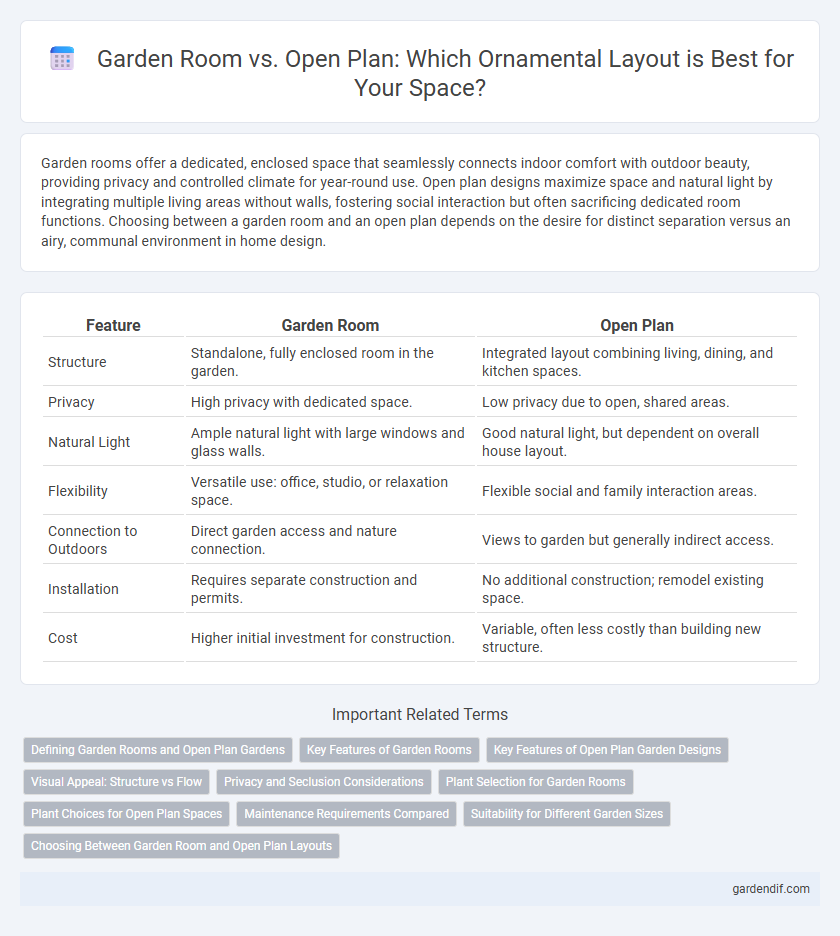
Garden Room vs Open Plan Illustration
Garden rooms offer a dedicated, enclosed space that seamlessly connects indoor comfort with outdoor beauty, providing privacy and controlled climate for year-round use. Open plan designs maximize space and natural light by integrating multiple living areas without walls, fostering social interaction but often sacrificing dedicated room functions. Choosing between a garden room and an open plan depends on the desire for distinct separation versus an airy, communal environment in home design.
Table of Comparison
| Feature | Garden Room | Open Plan |
|---|---|---|
| Structure | Standalone, fully enclosed room in the garden. | Integrated layout combining living, dining, and kitchen spaces. |
| Privacy | High privacy with dedicated space. | Low privacy due to open, shared areas. |
| Natural Light | Ample natural light with large windows and glass walls. | Good natural light, but dependent on overall house layout. |
| Flexibility | Versatile use: office, studio, or relaxation space. | Flexible social and family interaction areas. |
| Connection to Outdoors | Direct garden access and nature connection. | Views to garden but generally indirect access. |
| Installation | Requires separate construction and permits. | No additional construction; remodel existing space. |
| Cost | Higher initial investment for construction. | Variable, often less costly than building new structure. |
Defining Garden Rooms and Open Plan Gardens
Garden rooms are defined as enclosed or semi-enclosed outdoor spaces designed to create a distinct, intimate environment within a garden, often featuring structural elements like pergolas, glass walls, or landscaping that forms natural boundaries. Open plan gardens, in contrast, emphasize spaciousness and fluidity, minimizing physical barriers to foster seamless interaction between different garden zones and the surrounding environment. The choice between garden rooms and open plan gardens influences functionality, privacy, and aesthetic appeal, shaping how outdoor living spaces are experienced and utilized.
Key Features of Garden Rooms
Garden rooms offer a versatile and private outdoor living space characterized by insulated walls, large windows for natural light, and customizable designs that blend seamlessly with garden landscapes. Unlike open-plan interiors, garden rooms provide a dedicated, weatherproof area ideal for work, relaxation, or entertainment, often featuring climate control and soundproofing. Their structural elements prioritize durability and style, incorporating sustainable materials and eco-friendly options to enhance both aesthetic appeal and environmental impact.
Key Features of Open Plan Garden Designs
Open plan garden designs emphasize seamless integration between indoor and outdoor spaces, creating an expansive and flexible living area. Key features include large glass walls or sliding doors that maximize natural light and provide unobstructed views of the garden, as well as minimal structural partitions to promote airflow and connectivity. These designs often incorporate multifunctional zones and natural materials to enhance aesthetic appeal and support a harmonious lifestyle.
Visual Appeal: Structure vs Flow
A garden room offers a defined structure that creates a striking visual focal point, blending ornamental design with natural surroundings for enhanced aesthetic impact. In contrast, an open plan emphasizes seamless flow and spaciousness, allowing ornamental elements to be appreciated within an uninterrupted living space. Choosing between structure and flow depends on whether visual appeal is rooted in architectural presence or harmonious integration.
Privacy and Seclusion Considerations
Garden rooms offer enhanced privacy and seclusion by creating a distinct, enclosed space separate from the main house, ideal for uninterrupted relaxation or work. Open plan layouts prioritize spaciousness and flow over privacy, often leading to shared visibility and noise throughout the area. Choosing a garden room ensures controlled access and sound insulation, essential for those valuing seclusion within ornamental garden settings.
Plant Selection for Garden Rooms
Garden rooms benefit from selecting shade-tolerant and humidity-loving plants such as ferns, spider plants, and peace lilies, which thrive in enclosed, controlled environments. Unlike open-plan gardens that accommodate sun-loving species like lavender or roses, garden rooms allow for a curated plant palette with a variety of textures and foliage to create a lush, indoor-outdoor feel. Optimizing plant selection for garden rooms enhances air quality and aesthetic appeal, making these spaces perfect for year-round greenery regardless of external weather conditions.
Plant Choices for Open Plan Spaces
Open plan spaces benefit from plant choices that enhance spatial flow and create natural boundaries, such as tall snake plants, fiddle leaf figs, and bamboo palms. Opt for low-maintenance, air-purifying plants like pothos and spider plants that thrive in varying light conditions typical of open layouts. Incorporating vertical planters or hanging greenery maximizes space efficiency while adding texture and visual interest to the open plan environment.
Maintenance Requirements Compared
Garden rooms typically demand more routine maintenance due to exposure to outdoor elements, including regular cleaning, weatherproofing, and pest control to preserve structural integrity and appearance. Open plan interiors benefit from controlled indoor environments, reducing the need for frequent upkeep and making it easier to maintain consistent temperature and cleanliness. Both options require tailored approaches; however, garden rooms often incur higher long-term maintenance costs due to increased vulnerability to environmental factors.
Suitability for Different Garden Sizes
Garden rooms offer a versatile solution for small to medium-sized gardens, maximizing usable space without overwhelming the outdoor area. Open plan designs suit larger gardens, providing expansive views and seamless indoor-outdoor integration that enhances garden aesthetics. Both options improve ornamental appeal but must be chosen based on garden size and layout to optimize functionality and visual harmony.
Choosing Between Garden Room and Open Plan Layouts
Garden rooms offer a dedicated, aesthetically pleasing space that enhances indoor-outdoor living and provides privacy for relaxation or work. Open plan layouts maximize spatial flow and natural light, fostering social interaction but may lack the defined boundaries needed for focused activities. Choosing between garden room and open plan designs depends on prioritizing privacy and connection to nature versus an expansive, communal atmosphere.
Garden Room vs Open Plan Infographic

 gardendif.com
gardendif.com